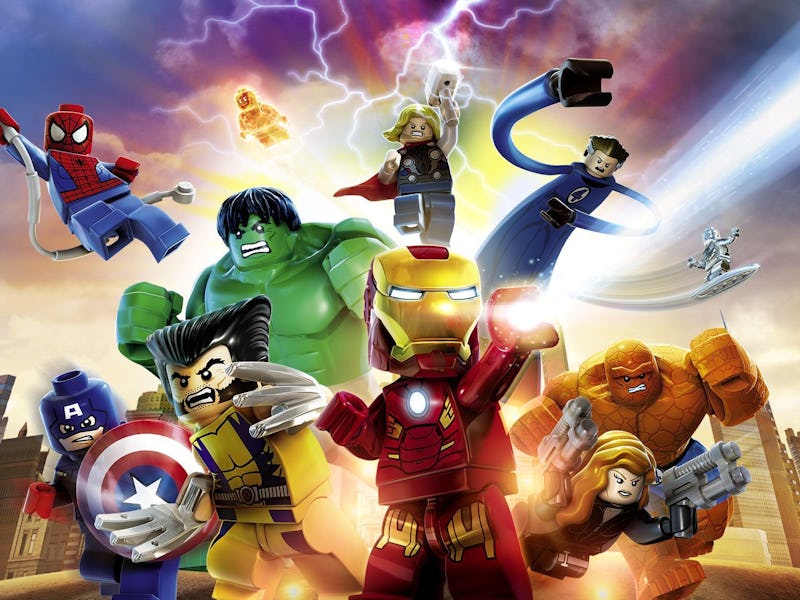A Love Letter to Lego Games and Brand Synergy Crossovertainment
Lego is like peanut butter to pop culture's chocolate.

The power of Lego is such that the toy manufacturer’s brick world can comfortably consume and subsume any intellectual property, no matter how valuable. This seems to work because of what physicists don’t call the Crossover Theorem: One popular thing plus another popular thing equals a really popular thing. Marvel, DC, Star Wars, and everything in-between have made video game content with Lego as it has morphed into something between a meta-brand and a genre.
If the Lego games have any signature trademark, it would be that they’re rarely meant for more than just silly fun. It’s difficult to imagine what a “serious” Lego game would even look like. Instead, the many Lego games have always taken a tongue-in-cheek approach to whatever property it was merging with Denmark’s favorite bricks. Just take a look at the trailer for the new Lego Star Wars: The Force Awakens to get a feel for the irreverent approach to pop culture the Lego games employ.
Coincidentally, the first Lego franchise game I played was 2005’s Lego Star Wars: The Video Game and the memory of it has stuck with me ever since. Alternating between what felt like an unlimited roster of Star Wars characters, I was struck by the clever way developer Traveller’s Tales translated the galaxy’s roster into Lego brick form. It wasn’t even so much that I got to play as my favorite characters, it was that they played like how I would imagine someone like Boba Fett would play, just in Lego form.
Flying around with Fett’s jetpack, or wielding four lightsabers like General Grievous felt amazing to my young self, and a decade later I’m still having similar experiences. Whether it’s flying around as Iron Man, or playing as J.J. Abrams in Lego’s Force Awakens game, the same levels of comfort and design are present. And that’s despite the fact that the Lego video game brand’s shuffled between developers.
Lego Batman
The long history of Lego games goes back to 1997, when Lego opened up a publishing arm to release video games. The company renamed the arm Lego Software in 2001, and Lego Interactive a year later, and the publisher ultimately closed and former staff started an independent development company, Giant Interactive Entertainment, in 2004. That company was soon absorbed by developer Traveller’s Tales in 2005, forming TT Games. The joint company, which kept Traveller’s Tales as a development branch was bought by Warner Bros. Interactive Entertainment in 2007.
The Warner Bros. acquisition helped pave the way for last year’s ambitious, and frankly a little bloated, Lego Dimensions. Another one of those “toys-to-life” hybrids like Skylanders, or the now-defunct Disney Infinity games, Dimensions allows players to buy separate Lego toys that can interact with the video game, either by transferring the toy’s character into the game, or by unlocking special modes and stories.
Thanks to the Warner Bros. ownership, Lego Dimensions features franchises from Back to the Future, DC, Doctor Who, Ghostbusters, Jurassic World, The Simpsons, and more. Frankly, it’s overkill, and like actual Lego toys themselves, the financial toll quickly escalates the more you invest in Dimensions. Many outlets such as Wired have commented on the breathtaking level of brand synergy present in something like Dimensions.
Brands gone mad
The thing about licensed games is the simple truth that they’re part of a large, consumer-targeting symbiosis that’s meant to assault customers on multiple fronts. But the Lego games are a little different. Perhaps because there is a basic understanding that Lego combined with whatever popular franchise has a movie that summer is already so commercially oriented, there’s really no reason for pretense. It’s likely why the designers of the various Lego games feel so free when it comes to lampooning the very products they’re meant to be selling.
While the cynics can think of this as a parasitic relationship of corporate consumerism between toys, films, video games, and comics, the games simply don’t care. Lego and, by extension, Lego versions of pop culture, are just fun to play with, and the sales figures speak for themselves. Toy-to-life games have generated nearly $4 billion in profits for companies like Activision, and that’s without a trusted brand like Lego designing the toys.
Tapping into the spring of goodwill Lego has accumulated over the decades, along with the immediate fervor over the big Hollywood crossover, customers stand little to no chance. And it would only be bad if the games were garbage. But they’re not, and part of that is due to the protective nature companies have over their brands, but also because the people who have been developing the Lego games for as long as they have, genuinely make fun games.
Sonic? They got you too?!
These games not only play well, but they play faithfully to both Legos as a product, and whatever character they’ve transfigured into a brick avatar. The writing is crowd-pleasing but curated to be as authentic to the source. The difficulties Traveller’s Tales put up with is that they have to maintain a certain level of quality for both Legos whatever they’re working with. Whether it’s The Avengers, Batman, Star Wars, or the obscene amount of franchises seen in Lego Dimensions.
The simple truth is that many of the Lego games are fluffy love letters to all of pop culture. If nothing else, the terrifying balance required for these brand monstrosities is impressive. Like one of the eight wonders of the capitalist world, Lego games stand apart from typical licensed video games. Their existence is a statement to the peanut butter meet chocolate mentality of marketing, but their execution’s a salute to good game design.